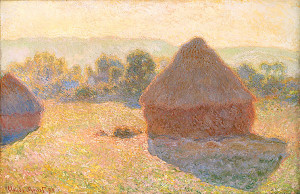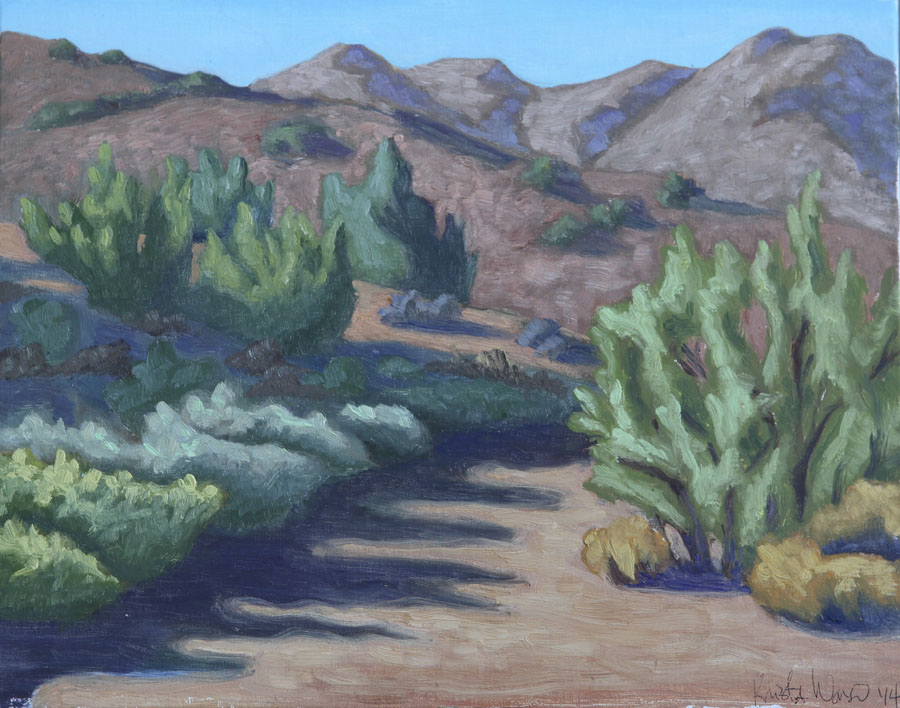Plein air painting has many benefits. Listed below are 10 reasons that I think are important. Check them out, and then get outside and paint! There’s no reason not to.
10. Being outside gives you needed vitamin D: The benefits of vitamin D are incredible: Aids the immune system, reduces the risk of MS, helps maintain cognitive functioning later in life, helps maintain a healthy body weight, can reduce the symptoms and severity of asthma attacks, reduces the risk of rheumatoid arthritis in women, protects from low levels of radiation, reduces the risk of cancer, aids in recovery from TB, and reduces the risk of heart attack. These reasons alone should get you outside painting! http://www.medicalnewstoday.com/articles/161618.php
9. You get some exercise: especially if you hike around a bit to find a great spot to paint. Carting all your materials with you adds to the physicality of the activity. Getting what I call “incidental exercise” is always a good thing – way more fun than having to go to the gym.
8. You get to see places you might not go to or appreciate otherwise. Living close to a national park, state park, or other tourist destination does not guarantee that you frequent them. Once you start plein air painting, you may just become a regular. There are members of The High Desert Plein Air Artists that have never been to some of the locations we have gone even though they live close, and probably pass by them on a regular basis. In searching for new places to paint I have discovered areas that I never knew existed. You might even discover that your yard holds incredible potential when you don’t have time to travel elsewhere. Once you become hooked on plein air painting, you won’t look at the world around you quite in the same way – everything becomes a potential subject.
7. You get to experience your subject matter on all sensory levels – not just sight. When you are in your studio, working from a photograph, the only sensory stimulation you get is the visual from the photo. Every other sense is basing input on your studio’s environment. When you are out, immersed in your subject matter, you not only see it, but you are feeling the wind, sun, and temperature, you are smelling the plants and earth around you, you are hearing animals in the bushes, the wind in the trees, and you might even have the opportunity to taste some berries growing on a bramble (OK, that one might be a stretch, but I hope you are getting my point). All that sensory input is contributing to your interpretation of the area you are painting and comes through, resulting in a richer and more inspired piece. Paintings done in studio from photographs just seem more sterile to me.
6. You get to meet people from all over the world. I always find it interesting to see how many different languages I hear when I am out painting. Some people have a genuine interest in what you are doing and like to ask questions. Others will just make a kind comment and pass on by, and then there are those that don’t acknowledge you in any way. Everyone has their own comfort level dealing with strangers. Personally, I don’t mind talking briefly to people. Some really like to talk, and that can get a little frustrating when you know your light is changing fast and you want to get back to painting, but for the most part that hasn’t been my experience. I guess as an educator I feel compelled to indulge people’s curiosity. I try to always be polite. You just never know, some viewers might even become future customers (I usually have business cards on hand just in case). Also, if you join a plein air group, you get to meet other artists that share your passion. I have been so fortunate to have met many lovely people that I would probably never have known otherwise.
5. You get to join a small, but growing, group of artists that are carrying on a time honored tradition of master artists of the past. You will be following in the footsteps of great artists such as: Claud Monet, Pierre- Auguste Renoir, Winslow Homer, John Singer Sargent, Mary Cassatt, William Merrit Chase, Paul Cezanne, Vincent Van Gogh, Maynard Dixon, and Edgar Payne to name a few. I am certainly not at their level of mastery, but I feel pleased knowing that I can share this practice with them. Today, the plein air movement is catching on. Artists around the world are taking up the challenge to paint in the open air. Plein Air Magazine is one of the best-selling art magazines, and plein air events, competitions, workshops and conventions are becoming more plentiful every year. All these people can’t be wrong!
4. You will create memories of your experiences that go far beyond a simple photograph. They are your interpretations; you choose what is important, a camera can’t do that. How many times have you been on a vacation or out for the day and have taken pictures of what you think are amazing shots, only to get home, view the photos, and wonder what it was that was so spectacular about the picture you took? I don’t know about you, but this used to happen to me all the time. I would have all these pictures taken with the intention of doing amazing paintings from them, only to look at the photos and think, “What was so great about this?” Had I been there painting plein air, I would have been able to capture what impressed me and not have had to trust a camera to record it.
3. You will take your paintings to a different level. If you have been accustomed to basing your paintings on photographs, painting from life will probably be a challenge at first. Photographs are already cropped down and in 2 dimensions, so translating them to canvas or paper does not require the same observation that painting from life does. When you are outside with the world around you life- sized, you have a lot to look at and many decisions to make. You need to decide on your composition, what you will include, what you will leave out, how you will simplify the details, and how you will interpret the 3 dimensional world in 2 dimensions on your canvas. You will be learning to really see for yourself, and you will be eliminating your dependence on photographs. All these decisions you are making and skills you are learning will ultimately result in your abilities as an artist to soar.
2. You will learn to paint fast and make quick decisions. When you paint outside, the world around you is changing. The sun moves across the sky and changes the patterns of light and shadow. Clouds move across the sky, changing their shapes and the light. As the day moves on, the colors that you see shift and change. It fascinates me how paintings based on the same place have different color influences based on the time of day. Monet had this same fascination when he painted his wheatstacks. 
The subtleties of these shifts cannot be recorded with a camera, at least not any camera I own, and need to be experienced and observed in real life. Because of all these changes, plein air artists need to make quick decisions and paint fast. This is why plein air artists tend to work small. After an hour or so, the light has changed significantly, and after 2 hours the scene is nearly unrecognizable to what is was when you started. Painting quickly loosens up your brushstrokes and helps an artist focus on what is really important in a scene. This distillation of the scene, in the end, improves the painting.
1. Your studio paintings will improve. Many plein air artists work in their studios also. Some days the weather doesn’t cooperate, you don’t have time to get out, or you want to work on a larger piece. All of your outdoor experiences will come through in your studio work. I base my studio work on my plein air pieces when I want to work on a larger piece. Sometimes I will continue to work on my plein air pieces from my memory. I almost never use photographs any more. If I have taken a picture of a scene I was working on, I usually find them so inadequate that they are of little use to me. When you do work in your studio, you will find yourself making decisions based on all of the intense observation you participated in while painting plein air. You will know your subject matter on a deeper level, and that will come out in your studio work. Isn’t becoming a better artist what all artists want? Plein air can get you there.
I hope that these reasons will inspire you to get out and give plein air a try. Consider it a challenge! You have absolutely nothing to lose, and the potential benefits are worth any risk you might be imagining. If you don’t want to go out by yourself, there are plein air groups in most areas. If you live in the high or low desert area, and would like to become part of the High Desert Plein Air Artists, contact me and I will put you on our e-mail list. We meet the 3rd Saturday of each month at various locations and would love to have you join us!
If you can think of other benefits of plein air painting that I haven’t mentioned, please share them in the comments!
If you want to be notified of future posts you can subscribe to this blog. If you know people who might be interested in this blog, please share it with them. I want to share the joy of plein air painting with as many people as I can, and you can help me!
[contact-form][contact-field label=’Name’ type=’name’ required=’1’/][contact-field label=’Email’ type=’email’ required=’1’/][contact-field label=’Website’ type=’url’/][contact-field label=’Comment’ type=’textarea’ required=’1’/][/contact-form]

